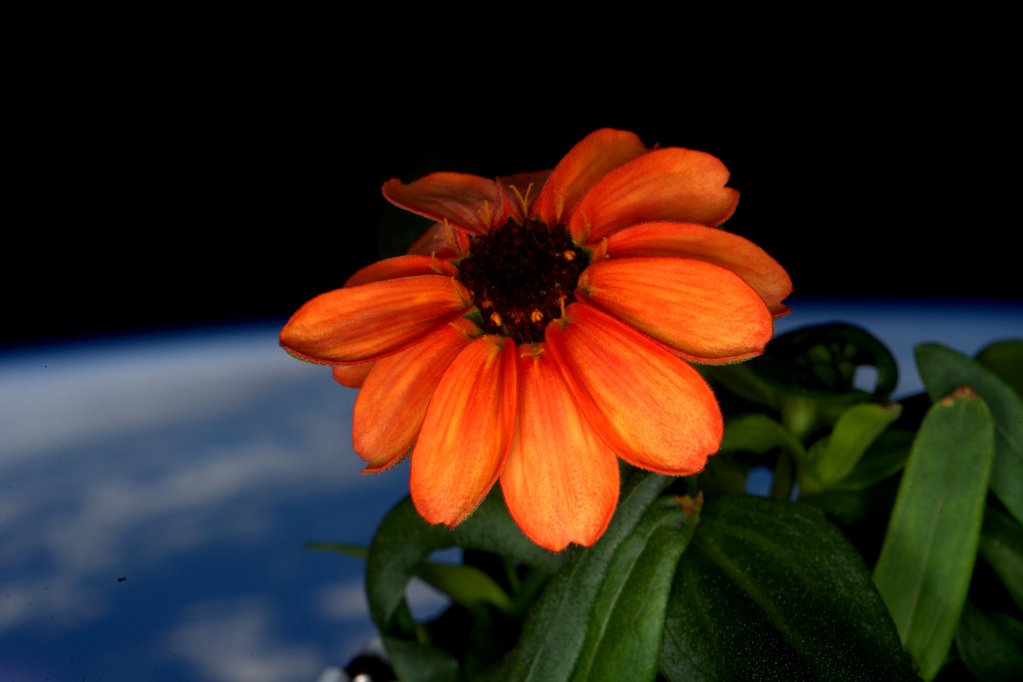The very first flower grown in space has bloomed aboard the International Space Station, marking yet another first and United States astronaut Scott Kelly has captured a photograph of the historical event, which he shared on Twitter.
While the zero-gravity grown flower, an orange zinnia with 13 petals, might appear to be wilting and molding–which it apparently is–NASA indicated in a statement that science is actually “blooming stronger than ever” and what might “seem like a failure in systems is actually an exceptional opportunity for scientists back on Earth to better understand how plants grow in microgravity, and for astronauts to practice doing what they’ll be tasked with on a deep space mission: autonomous gardening.”
Dr. Gioia Massa with NASA Veggie noted that while their plants have failed to grow “perfectly” in space, she believes that scientists have “gained a lot from this” and that they’re continue to learn “more about plants and fluids and also how better to operate between ground and station.”
While the plants haven’t grown perfectly […] I think we have gained a lot from this, and we are learning both more about plants and fluids and also how better to operate between ground and station. Regardless of final flowering outcome we will have gained a lot.
In his post on Twitter, NASA’s Scott Kelly wrote, “#SpaceFlower out in the sun for the first time!” He added “#YearInSpace” as a second hashtag. The tweet, which was posted at 2:16 p.m. on January 17, received over 5,300 retweets and more than 9,600 likes.
#SpaceFlower out in the sun for the first time! #YearInSpace pic.twitter.com/Cghu9XGv1J
— Scott Kelly (@StationCDRKelly) January 17, 2016
Earlier this month, Kelly shared a photo of his space flowers on the rebound.
https://twitter.com/StationCDRKelly/status/685443155404140545/photo/1?ref_src=twsrc%5Etfw
Commander Kelly, who has spent more time living in space than any other American astronaut, is on a special year-long mission aboard the ISS which is scheduled to end on March 3, 2016. At which point, he’ll have spent a combined 522 days living in space between the four missions he’ll have successfully embarked on and returned from.
In an anticipation of his upcoming return to Earth, he shared a picture of Texas from space along with the caption, “#GoodMorning #Texas! Looking forward to seeing you soon.”
#GoodMorning #Texas! Looking forward to seeing you soon. #YearInSpace pic.twitter.com/SUfmAJOrmc
— Scott Kelly (@StationCDRKelly) January 17, 2016
The first space flower comes as the second plant grown aboard the orbiting laboratory. The first plant was ‘Outredgrous’ red romaine lettuce and according to NASA, it saw “some issues” during its initial growth cycle. But after the first space crop’s failure in which a couple of plants were lost to drought stress, a second crop was initiated which actually managed to stay on course and deliver lettuce just a month after it was started.
Elaborating upon why the next crop, the recently bloomed zinnia flowers, were selected, Veggie project managed Trent Smith explained that they’re “more sensitive to environmental parameters and light characteristics,” plus they have “a longer growth duration between 60 and 80 days.” Taking these variables into consideration, they’re “more difficult” to grow and that makes them “a good precursor to a tomato plant.”
Come 2018, scientists are planning to transport dwarf tomato seeds up to the space station to be grown and according to Smith, the lessons learned growing zinnias will prove critical when it comes time to grow the tomatoes.
























